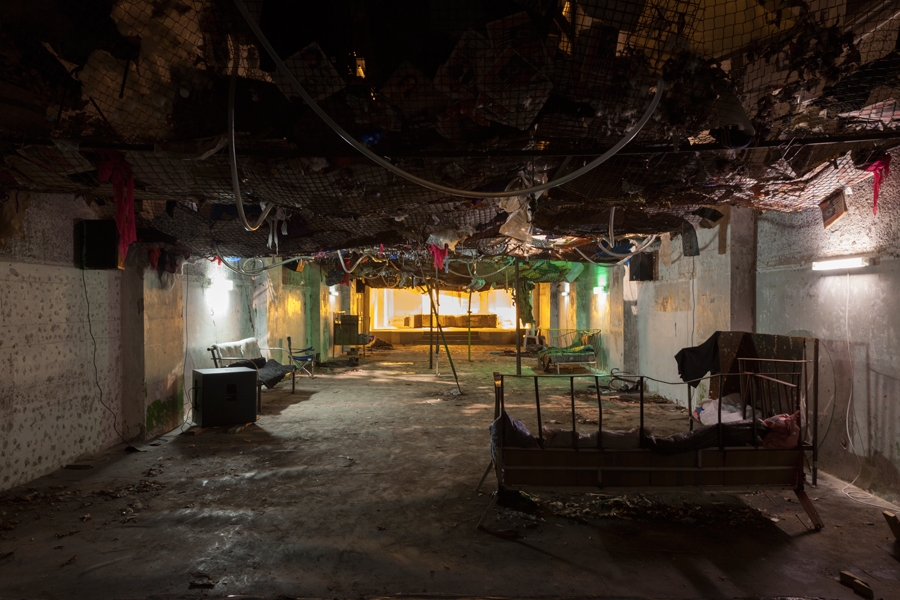In the now-derelict, early twentieth-century poured-concrete church of Dilston Grove, artists Ben Burgis, Stuart Middleton and Richard Sides have created their own version of the Mechanical Garden, curated by Naomi Pearce, an installation sketched out but not realised by late British avant-garde artist Stephen Cripps (1952–82). While not an accurate realisation of the original design – Cripps’s garden resembled a theme-park straight out of Jean Tinguely’s brain, where everything is mechanised, from a self-erecting tree and spinning garden umbrellas to rows of flowers that dig and chuck earth about – the trio’s installation is an evocation of and a tribute to his work. Known for his ephemeral performance-based works, which combined mechanical sculptures made from found objects, urban sounds and explosives, Cripps’s spirit emerges from this highly sensory sculpture and sound installation, which in turn leaves you feeling somewhere between nostalgic for the past and anxious for the future.
Occupying almost the whole of the nave, an accumulation of rubbish, mattresses, cushions, scrap metal, plastic bags and random objects including a laundry basket, a number plate and an abandoned fish-shaped cuddly toy, is held aloft by a large net, looming overhead like a precarious ceiling; at the end of it, standing in the place of the altar, other pieces of junk and urban debris float around in the russet foaming water of an artificial pond, in which only a few water plants manage to survive. Improvised sofas and camping chairs invite visitors to sit and listen to a sound piece that resonates in the acoustics of the space, and which features, among other things, interviews assembled within an essay by writer Alice Hattrick, sound recordings from construction sites and explosions, musical contributions by experimental artist and percussionist Z’EV and Berlin-based musician Steven Warwick (aka Heatsick), and an essay by writer Patrick Langley reflecting on the installation through the history and metaphor of the garden.
Beyond preserving the legacy of an underground artist, the show points out the relevance of Cripps’s way of producing and showing art for contemporary artists
Particularly captivating, Hattrick’s essay featuring recollections and anecdotes by Cripps’s friends and collaborators (such as ACME studios founder Jonathan Harvey, artist Richard Wilson and performer Anne Bean) conjures up not without nostalgia a time of collectivism and selforganisation when Cripps was living among a large colony of artists unofficially established in the empty Victorian warehouses of Butler’s Wharf. Beyond preserving the legacy of an underground artist, it points out the relevance of Cripps’s way of producing and showing art for contemporary artists, which is in turn illustrated by the collaborative crowd of artists, writers and musicians involved in the show. If Butler’s Wharf was an early flagship of the gentrification and privatisation process during the 1990s, this is again becoming an urgent issue for contemporary art spaces today (the Woodmill, a studio-and-gallery-space group behind the production of this exhibition, is currently in search of an affordable new location).
But what resonates even more in this Mechanical Garden is Cripps’s fascination for the city, its noises and all the waste it generates – which he harvested from the riverbanks and recycled into his sculptures, turning them into archaeological relics of the postindustrial city. Urban sounds collected in London, poems and a psychogeographic narration guiding us through Bermondsey and beyond by Laura Oldfield Ford enhance the city as a focus, which is materialised through the trio’s accumulative installation. Only here, the scrap metal of the mechanics that were to populate and activate Cripps’s garden have been replaced by proper trash, and nothing seems to function any more. In times of heightened environmental awareness, Burgis, Middleton and Sides’s Mechanical Garden has emancipated itself from Cripps’s archaeology of metal objects, to become a rather alarming dystopian projection of days to come; as I leave the exhibition, an automated voice from Simon Werner’s sound piece chants mechanically, “What’s the remedy? What’s the remedy?”
Listen to the whole audio guide of The Mechanical Garden on soundcloud.
This article was first published in the December 2014 issue.
